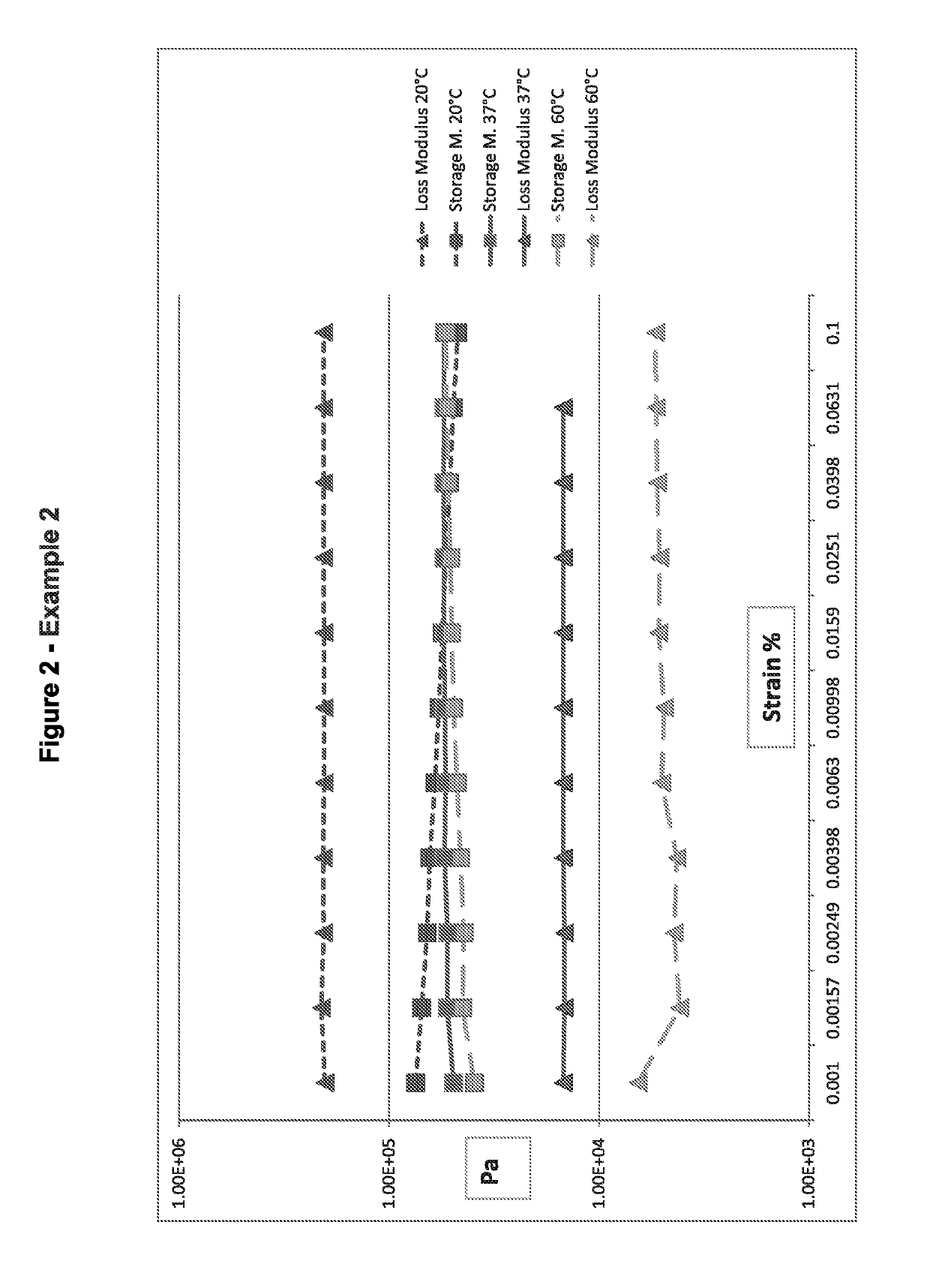Composition containing glycosaminoglycans and proteins
a glycosaminoglycan and glycosaminoglycan technology, applied in the field of glycosaminoglycans and proteins, can solve the problems of limited mechanical properties of viscoelastic solids or semi-solids, limited properties for biological, pharmacological or medicinal use,
- Summary
- Abstract
- Description
- Claims
- Application Information
AI Technical Summary
Benefits of technology
Problems solved by technology
Method used
Image
Examples
example 1
Preparation a
[0052]In a reactor fitted with a mechanical agitator we add 20 parts of Triglycerol (Polyglycerol-3; Solvay), 50 parts of diethyl carbonate and 0.5 part of sodium carbonate finely grounded.
[0053]The blend under agitation is heated over a period of one hour to 90° Celsius, until the mixture appears homogenous. It is than slowly heated to 130° Celsius in one to two hours and then kept at the temperature for another one to two hours. The ethyl alcohol formed during the reaction is eliminated by distillation. After three hours, the mixture is placed under vacuum of about 15 mbar to remove residues of ethyl alcohol and diethyl carbonate.
[0054]The mixture is hot filtered to remove the catalyst and 1.5 parts of Chondroitin-4-sulphate sodium salt (Sigma-Aldrich) is added.
Preparation b
[0055]We add 1.5 part of chemically hydrolysed collagen type II of porcine origin (Meitek Technology Qingdao Co. Ltd) to 20 parts of 1,3-diamino-2-propanol. The preparation b is kept under agitatio...
example 2
Preparation a
[0058]In a reactor fitted with a mechanical agitator we add 20 parts of Triglycerol (Polyglycerol-3; Solvay), 12 parts of Sorbitol (Sigma-Aldrich), 100 parts of diethyl carbonate and 1 part of sodium carbonate finely grounded.
[0059]The blend under agitation is heated over a period of one hour to 115° Celsius, until the mixture appears homogeneous. It is than slowly heated to 130° Celsius in about one hour and then kept at the temperature for another one to two hours. The ethyl alcohol formed during the reaction is eliminated by distillation. After three hours, the mixture is placed under vacuum of about 15 mbar to remove residues of ethyl alcohol and diethyl carbonate.
[0060]The mixture is hot filtered to remove the catalyst and 3.2 parts of Chondroitin-4-sulphate sodium salt (Sigma-Aldrich) are added.
Preparation b
[0061]We dissolve 0.7 part of insoluble Type I collagen from beef Achilles tendon (Sigma-Aldrich) in 7 parts of 1,3-diamino-2-propanol, 4.9 parts of 3,6-dioxao...
example 3
Preparation a
[0063]In a reactor fitted with a mechanical agitator we add 23.3 parts of Triglycerol (Polyglycerol-3; Solvay), 6.7 parts of Diglycerol (TCI Europe N.V), 75 parts of diethyl carbonate and 1.5 part of sodium carbonate finely grounded. The blend under agitation is heated over a period of one hour to 90° Celsius, until the mixture appears homogeneous. It is than slowly heated to 130° Celsius in about one hour and then kept at the temperature for another one to two hours. The ethyl alcohol formed during the reaction is eliminated by distillation. After three hours, the mixture is placed under vacuum of about 15 mbar to remove residues of ethyl alcohol and diethyl carbonate. The mixture is hot filtered to remove the catalyst and 2 parts of Chondroitin-4-sulphate sodium salt (Sigma-Aldrich) are added.
Preparation b
[0064]We dissolve 1 part of insoluble Type I collagen from beef Achilles tendon (Sigma-Aldrich) in 10 parts of 1,3-diamino-2-propanol. We add 1 parts of chemically h...
PUM
| Property | Measurement | Unit |
|---|---|---|
| molar ratio | aaaaa | aaaaa |
| molar ratio | aaaaa | aaaaa |
| volume | aaaaa | aaaaa |
Abstract
Description
Claims
Application Information
 Login to View More
Login to View More - R&D Engineer
- R&D Manager
- IP Professional
- Industry Leading Data Capabilities
- Powerful AI technology
- Patent DNA Extraction
Browse by: Latest US Patents, China's latest patents, Technical Efficacy Thesaurus, Application Domain, Technology Topic, Popular Technical Reports.
© 2024 PatSnap. All rights reserved.Legal|Privacy policy|Modern Slavery Act Transparency Statement|Sitemap|About US| Contact US: help@patsnap.com










